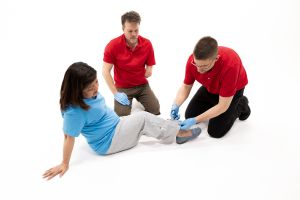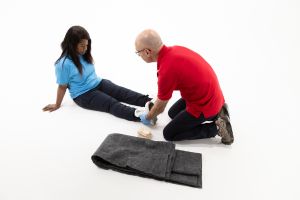In this blog, we'll talk about different kinds of injuries and give you some important tips for first aid. We'll cover topics like the difference between a fracture and a break, and explain the RICE (Rest, Immobilize, Cool, Elevate) method for treating a sprain or strain. This guide will give you the information you need to be ready in case of an emergency.

What is A Fracture?
Fractures can result from various causes, including acute trauma or underlying medical conditions. They usually happen in intense situations where a lot of force is put on the bone.
For example, contact sports (football, hockey) or sports with falls (skiing, skateboarding) can cause limb fractures, including a broken leg or fractured leg.
Falling from a height or slipping on a hard surface can also cause bones to break, particularly in older adults or those with balance issues, leading to injuries like a broken bone in the leg or even a back injury.
Doing the same movements over and over without taking breaks, such as running or dancing, can lead to stress fractures. This is especially true in weight-bearing bones, like the tibia (shinbone), thigh bone, or metatarsals (foot bones).
Knowing the cause of a bone fracture is essential. It helps to find the right treatment and prevent future injuries, especially in high-risk people.
What Is the Difference Between a Fracture and a Broken Bone?
You might have heard people use the terms fracture and break when discussing bone injuries. But actually, they are pretty much the same thing.
1. Fracture:
Definition: When a bone breaks, no matter how badly, we call it a fracture. The bone can be cracked, chipped, or totally broken into pieces.
Types: There are various types of fractures, such as hairline fractures, compound fractures (where the bone pierces the skin), and comminuted fractures (where the bone shatters into several pieces). A fractured leg is a common example, which can vary in severity and type.
Symptoms: Pain, swelling, bruising, and inability to move the affected area. The limb or affected area may also appear deformed.A break is essentially the same as a fracture. The term "break" is more commonly used in everyday language, while "fracture" is a more medical term.
2. Break:
Types and Symptoms: The types and symptoms are the same as for a fracture, as they refer to the same condition.
What Is the Best First Aid for A Fracture?
If you or someone around you thinks they have fractured a bone, it's essential to act fast and effectively to give the proper care and prevent further injuries. Here are the steps to follow:
- Stay Calm: Try to keep the person calm and reassure them that help is coming.
- Immobilize: Avoid moving the fractured bone to prevent further damage. This is crucial, especially for injuries like a broken leg or fractured legs.
- Call for Help: If the injury is severe, such as a compound fracture (where the bone is sticking out through the skin), a large bone fracture (e.g., thigh bone, hip), or signs of shock, call emergency services immediately.
- Use a Splint: Use a splint or padding to immobilize the area in the position in which it was found. If you don't have a proper splint, you can use a rigid item like a board, rolled-up newspaper, or even a sturdy piece of clothing to stabilize the limb.
- Secure the Splint: Secure a splint above and below the fracture with bandages, cloth strips, or even tape. Avoid tying it too tightly, as this can cut off circulation.
- Apply Ice: Apply ice packs wrapped in a cloth to the injured area for 15-20 minutes every hour to reduce pain and swelling, if it does not cause the person any discomfort to do so.
- Elevate: If the person can comfortably do so, elevate the injured limb above the level of the heart to help reduce swelling.

What is the Difference Between a Strain and a Sprain?
Sprains and strains are both common injuries but involve different tissues in the body: 1. Sprain
Definition: A sprain is an injury to a ligament, the fibrous tissue that connects bones to other bones at a joint. Sprains occur when a ligament is stretched or torn due to an unexpected twist, fall, or impact. This can often be confused with more severe injuries like a broken leg or a bone fracture, especially when the symptoms are intense.
Common Areas: Ankles, knees, wrists, and thumbs are the most sprained areas. However, severe sprains can sometimes be misinterpreted as a broken leg injury or even a fracture in the foot bones.
Symptoms:
- Pain at the injured joint, for example, the ankle.
- Swelling and bruising
- Limited ability to move the affected joint
- Sometimes a "popping" sound or feeling at the time of injury, which may cause one to worry. For example, they may have a sprained ankle or a more severe ankle sprain.
Definition: A strain is an injury to a muscle or tendon (the tissue that connects muscles to bones). Strains occur when a muscle or tendon is stretched too far or torn, often due to overuse or sudden, forceful movements. Strains, while different, can sometimes be mistaken for a sprained ankle or other bone-related injuries, particularly in areas close to foot bones or ankles.
Common Areas: Strains commonly affect the lower back, hamstrings, and shoulders. Strains in these areas can sometimes be confused with more severe conditions, such as a sprained ankle involving a bone fracture.
Symptoms:
- Pain in the affected muscle or tendon
- Swelling and inflammation
- Muscle spasms or cramping
- Weakness or difficulty moving the affected area
Sprains involve ligaments (tissue connecting bones to other bones) and occur at joints. Strains involve muscles or tendons (tissue connecting muscles to bones), often affecting the back, legs, or shoulder muscles.
Both injuries can cause pain, swelling, and limited movement, but the treatment may differ depending on the severity and location of the injury.
What is The First Aid Treatment for Sprains or Strains?
When someone gets a sprain or strain, taking care of it immediately is important to reduce swelling and pain and prevent further injury. The usual treatment for a sprain is often simplified as RICE (Rest, Immobilize, Cool, Elevate). Here's what to do: 1. Rest
Have the person stop any current activities and rest without moving or straightening the injured body part.
2. Immobilize
If you need to move the person or if Emergency Medical Services (EMS) response will be delayed, immobilize the injured area in the position in which it was found by creating a splint. Otherwise, keep the person still and do not splint the injury.
3. Cool
If it does not cause the person any discomfort, cool the injured area for 20 minutes of every hour to reduce swelling and pain. The part should be cooled for 20 minutes of every hour for up to 48 hours. Do not rub the ice or cold pack on the injured area. If you use ice, put a thin, dry cloth or pad between it and the person’s bare skin to avoid freezing the skin.
4. Elevate the injury
Keep the injured area above the level of the heart, if possible. However, do not raise the injured area if moving it will cause pain.
Call 9-1-1 if you suspect a head, neck or back injury, if the injury makes walking difficult, if it is a thigh bone or pelvis injury, or if the person is no longer fully conscious.
Avoid applying heat to the injury during the first 48 hours, as it can increase swelling. Avoid massaging the injured area immediately after the injury, which can increase swelling and worsen the injury.
Following these steps can help minimize the effects of a sprain or a strain and promote faster recovery.
Important Reminders
This article is a helpful reference but is not a replacement for proper first aid training. You can sign up for a First Aid course nearby to learn more and prepare yourself.More helpful information on sprains, strains, and fractures can be found in the Bone, Muscle, and Joint Injuries section of the Comprehensive Guide for First Aid & CPR.
Download the free Red Cross First Aid app today to quickly access life-saving tips and instructions.

